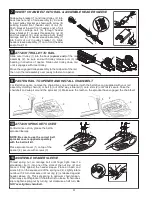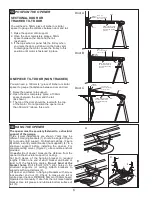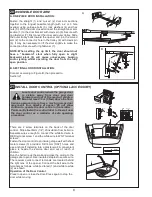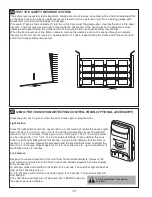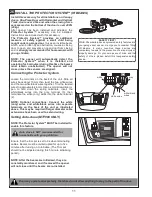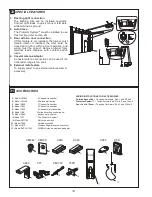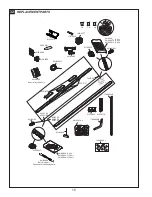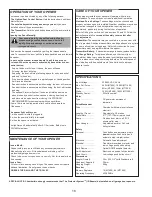
SPECIFICATIONS
Input Voltage ...........
230-240 VAC, 50Hz
Max. Pull Force .......
600N (MT600), 1000N (MT1000)
Power ......................
6Nm (MT600), 10Nm (MT1000)
Watts .......................
130W (MT600), 190W (MT1000)
Standby Power........
3 Watts nominal
Motor
Type ........................
DC gearmotor permanent
lubrication
Drive Mechanism
Drive........................
Chain/belt with two-piece trolley on
steel rail.
Length of Travel ......
Adjustable to 3.0 metres
Travel Rate..............
5"-7" (127-178mm) per second
Lamp .......................
On when door starts, off 2-1/2
minutes after stop.
Door Linkage...........
Adjustable door arm. Pull cord
trolley release.
Safety
Personal ..................
Push button and automatic stop in
down direction. Push button and
automatic stop in up direction.
Electronic ................
Automatic force adjustment
Electrical..................
Transformer overload protector and
................................
low voltage push button wiring.
Limit Device ............
Optical RPM/Passpoint detector.
Limit Adjustment......
Electronic, semi and fully automatic.
Start Circuit .............
Low voltage push button circuit.
Dimensions
Length (Overall) ......
3.2m (122-1/2")(with Standard rail)
Headroom Required
30mm
Hanging Weight.......
9.5kg
Receiver
Memory Registers ...
16 (MT600), 64 (MT1000)
Operating Frequency
433.92MHz
Your opener can be activated by any of the following devices:
• The Lighted Door Control Button. Hold the button down until door
starts to move.
• The outside keyswitch or keyless entry system (if you have
installed either of these accessories).
• The Transmitter. Hold the push button down until the door starts to
move.
Opening the Door Manually:
The door can be opened manually by pulling the release handle
down. To reconnect the door, pull the release handle down and toward
the opener.
Do not use the manual release handle to pull the door open
or closed. When the opener is activated by transmitter or door
control button:
1. If open, the door will close. If closed, the door will open.
2. If closing, the door will stop.
3. If opening, the door will stop (allowing space for entry and exit of
pets and for fresh air).
4. If the door has been stopped in a partially open or closed position,
it will reverse direction.
5. If an obstruction is encountered while closing, the door will reverse.
6. If an obstruction is encountered while opening, the door will reverse
and stop.
7. The optional Protector System™ uses an invisible beam which,
when broken by an obstruction, causes a closing door to open
and prevents an open door from closing. It is STRONGLY
RECOMMENDED for homeowners with young children.
Allow a 15 minute cooling period after 5 continuous operations
of the opener.
The opener light will turn on:
1. when opener is initially plugged in;
2. when the power is briefly interrupted;
3. when the opener is activated.
The light turns off automatically after 2-1/2 minutes. Bulb size is
230V/40W maximum.
OPERATION OF YOUR OPENER
18
When properly installed your opener will operate with minimal
maintenance. The opener does not require additional lubrication.
Limit and Force Settings: These settings must be checked and
properly set when opener is installed. Weather conditions may cause
some minor changes in the door operation, requiring some re-
adjustments, particularly during the first year of operation.
Refer to Setting the Limits and Force sections 22 and 23. Follow the
instructions carefully and repeat the safety reverse test after
any adjustment.
Transmitter: The transmitter may be secured to a car sun visor with
the clip provided. Additional transmitters can be purchased at any time
for use in all vehicles using garage. Refer to Accessories. Any new
transmitters must be programmed into the opener.
Transmitter Battery: If transmission range lessens, replace battery.
To Change Battery: To replace batteries, use the visor clip or
screwdriver blade to pry open the case. Insert batteries positive side
up. To replace cover, snap shut along both sides. Do not dispose of
the old battery with household waste. Take batteries to a proper
disposal centre.
CARE OF YOUR OPENER
Once a Month:
• Repeat safety reverse test. Make any necessary adjustments.
• Manually operate door. If it is unbalanced or binding, call for
professional garage door service.
• Check to be sure door opens and closes fully. Set limits and/or force
if necessary.
Once a Year:
• Oil door rollers, bearings and hinges. The opener does not require
additional lubrication. Do not grease the door tracks.
• GREASE THE RAIL AND THE TROLLEY.
MAINTENANCE OF YOUR OPENER
Door should be fully closed if possible. Weak or
broken springs could allow an open door to fall
rapidly. Property damage or serious personal
injury could result.
SPECIAL NOTE: Chamberlain strongly recommends that The Protector System
TM
(IR Beams) be installed on all garage door openers.

